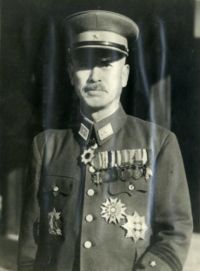- Mitsuru Ushijima
-
Mitsuru Ushijima 
General Mitsuru UshijimaNickname Demon General Born July 31, 1887
Kagoshima, Kagoshima Prefecture JapanDied June 22, 1945 (aged 57)
Okinawa, JapanAllegiance Empire of Japan Service/branch  Imperial Japanese Army
Imperial Japanese ArmyYears of service 1908-1945 Rank General Commands held IJA 32nd Army Battles/wars Siberian Intervention
Second Sino-Japanese War
World War IIAwards Order of the Sacred Treasures
Order of the Golden Kite (2nd class)Mitsuru Ushijima (牛島 満 Ushijima Mitsuru, 31 July 1887 – 22 June 1945[1]) was the Japanese general at the Battle of Okinawa, during the final stages of World War II.
Contents
Biography
Ushijima was a native of Kagoshima city in Kagoshima prefecture on the island of Kyūshū in southern Japan. He graduated from the 20th class of the Imperial Japanese Army Academy in 1908 and of the 28th class of the Army Staff College in 1916. Soon after graduation, he was assigned to the Japanese Expeditionary Force based at Vladivostok during the Siberian Intervention against Bolshevik forces during the Russian Civil War.
From 1933-1936, he served in administrative postings within the War Ministry. He was appointed commander of the IJA 1st Infantry Regiment from 1936-1937.[2]
With the start of the Second Sino-Japanese War, Ushijima was promoted to major general and appointed commander of the IJA 36th Infantry Brigade. He was recalled to Japan in 1938 to become Commandant of the Toyama Army Infantry School. However, in 1939, Ushijima was promoted to lieutenant general and again given a field command as general officer commanding the IJA 11th Division in central China, and participated in many battles in China and in Burma.
He returned to Japan again from 1941-1942 as Commandant of the Non-commissioned Officers Academy, and from 1942-1944 as Commandant of the Imperial Japanese Army Academy.
As the war situation continued to deteriorate for the Japanese in the Pacific War, Ushijima was sent to Okinawa to take command of the newly formed 120,000 man Japanese 32nd Army, charged with the defense of the Ryukyu Islands against American invasion. The 32nd Army consisted of the IJA 9th Division, IJA 24th Division, and the IJA 62nd Division, and the 44th Independent Brigade. The 9th Division was transferred to Taiwan prior to the American invasion. Ushijima commanded all Japanese forces in the southern portion of the Okinawa main island from his headquarters based in Shuri Castle in Naha. He led a skillful defense of the island despite disagreements between his second in command, General Isamu Cho, and his chief of staff, Colonel Hiromichi Yahara.
After an offensive action urged by Cho led to a near massacre of the attacking Japanese troops by superior American firepower, Ushijima adopted the defensive attrition tactics urged by Yahara. After the turning of the Shuri Line by the American forces, he led a successful withdrawal of his troops to the extreme south of the island. This defensive line did not meet with the same success, and became a fragmented grouping of isolated defensive positions. Ushijima and Cho retreated to Hill 89 at the south coast. The command and control of the remnants of the 32nd Army soon quickly deteriorated as communication with the last defensive positions was cut. Record numbers of Japanese prisoners surrendered; many were Okinawan volunteers or conscripts.
Ushijima refused a personal plea from the American General Simon Buckner to surrender. Instead, hearing the sounds of the systematic destruction of positions nearby on Hill 89, Ushijima and General Cho committed ritual suicide, each disemboweling himself with a short sword followed by his beheading by his principal aide.
Yahara was the most senior officer captured by American forces, and the most senior to survive the battle. Yahara had asked Ushijima for permission to commit suicide, but the general refused his request, saying, "If you die there will be no one left who knows the truth about the battle of Okinawa. Bear the temporary shame but endure it. This is an order from your army commander."[3] Yahara later authored a book entitled The Battle for Okinawa, describing Ushijima’s last moments.
Ushijima was described as a humane man who discouraged his senior officers from striking his subordinates, as was their right in the Imperial Japanese Army, and disliked displays of anger because he considered it a base emotion.
References
Books
- Fuller, Richard (1992). Shokan: Hirohito's Samurai. London: Arms and Armor. ISBN 1-85409-151-4.
- Hayashi, Saburo; Cox, Alvin D (1959). Kogun: The Japanese Army in the Pacific War. Quantico, VA: The Marine Corps Association..
- Toland, John (1970). The Rising Sun: The Decline and Fall of the Japanese Empire 1936-1945. Random House. ISBN 0812968581.
- Yahara, Hiromichi; Gibney, Frank B. (1995). The Battle for Okinawa. John Wiley & Sons, Inc.. ISBN 0-471-18080-7.
External links
- Ammenthorp, Steen. "Ushijima Mitsuru, General". The Generals of World War II. http://www.generals.dk/general/Ushijima/Mitsuru/Japan.html.
- Budge, Kent. "Ushijima, Mitsuru". Pacific War Online Encyclopedia. http://pwencycl.kgbudge.com/index.htm.
- Chen, Peter. "Ushijima, Mitsuru". WW2 Database. http://ww2db.com/person_bio.php?person_id=306&list=Ground.
Notes
- ^ "The War: Okinawa". PBS. http://www.pbs.org/thewar/detail_5232.htm. Retrieved 2009-09-09.
- ^ Ammenthorp, The Generals of World War II
- ^ John Toland, The Rising Sun: The Decline and Fall of the Japanese Empire 1936-1945, Random House, 1970, p. 723
Categories:- Japanese generals
- Japanese military personnel of World War II
- Japanese military personnel who committed suicide
- Operation Iceberg
- People from Kagoshima (city)
- Seppuku from Meiji period to present
- 1887 births
- 1945 deaths
Wikimedia Foundation. 2010.
